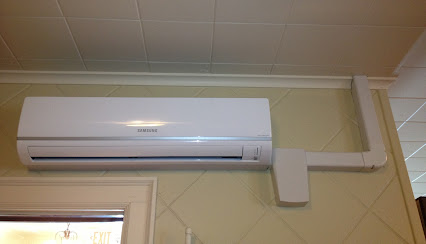Inspecting Mini-Split Heat Pumps

As more people want air conditioning in homes heated by hydronic or steam heat, we are seeing more ductless mini-split systems. Basically mini-split systems transfer heat / cool through the same refrigerant cycle as a conventional heat pump. The advantage is that each room or area has its own “mini” air handler and thermostat. This allows the homeowner to individually control the thermostat for that zone. Mini-Split systems also are more efficient and ensure less energy loss because the conditioned air is not traveling long distances through duct work. Also unused or underserved areas of the home can be eliminated or turned off. Mini-Split systems have an inverter driven compressor that allows the system to adjust capacity and operated down to 30% of their full rated capacity saving a considerable amount of energy and cost to the homeowner. A ductless heat pump’s indoor units are connected to the outdoor unit by conduits that contain the refrigerant tubing, electrical wiring, and condensate drain tubing. The conduits go through the home’s exterior wall. While most mini-split installations feature wall-mounted or ceiling-mounted air handlers, an alternative option that most manufacturers offer for homeowners who do not want to see the heads is a ducted mini-split that employ short runs of ductwork to one or multiple rooms. Also self contained air handlers that are ceiling or wall mounted that have exposed grills. This eliminates the large air handling units that some find unsightly. Inspecting these units is different in some ways to inspecting a conventional heat pump. Like any other heat pump, you should be looking at the age of the unit, proper leveling, adequate electrical supply, proper startup and cycling, leaks, & compressor noise.
So what are some other things a home inspector should be looking for:
- Ensure all penetrations in the house are properly sealed
- One thermostat should be provided for every “zone”
- Any supply or return duct in unconditioned space should be insulated with a minimum of R-8 where 3 inches in diameter and greater. R-6 where less than 3 inches in diameter.
- Supply ducts in other areas of the home shall be insulated to a minimum of R-6 where 3 inches in diameter or greater and R-4.2 where less than 3 inches in diameter.
- Stud / joist or other framing cavities should not be used as ducts for distribution
- The outdoor unit should be raised at least 3 inches above the ground
- Condensate discharge from all evaporator coils should be discharged in an area as not to come in contact with humans or animals. It should also not discharge into a street, alley, or other areas where it could create a nuisance.
- Condensate discharge pipe shall maintain a minimum horizontal slope of at least a 1 percent slope.
- Insulation on refrigerant suction pipe should be R-4
- Refrigerant circuit access ports located outdoors shall be fitted with locking type tamper resistant caps or shall be otherwise secured to prevent unauthorized access
- Insulation in exterior walls shall be fit properly around plumbing and wiring
Related Articles:
- Direct Vent Gas Fireplaces
- Looking For Back Draft
- Inspecting Heating / Cooling Ducts
- Inspecting Oil Tanks
Want To Learn More? Click HERE to Search Our Full Database Of Home Inspector Newsletters.



